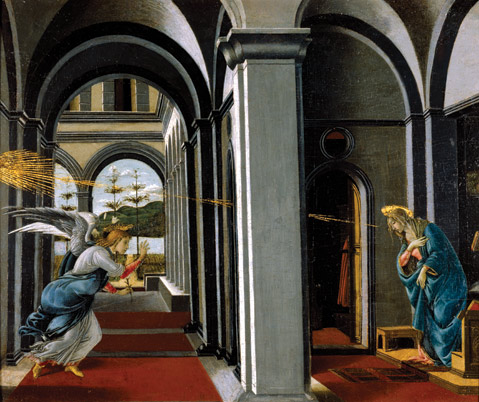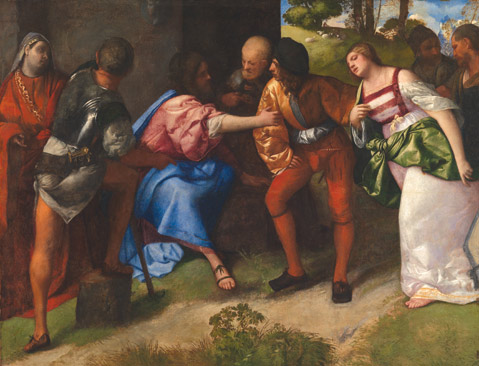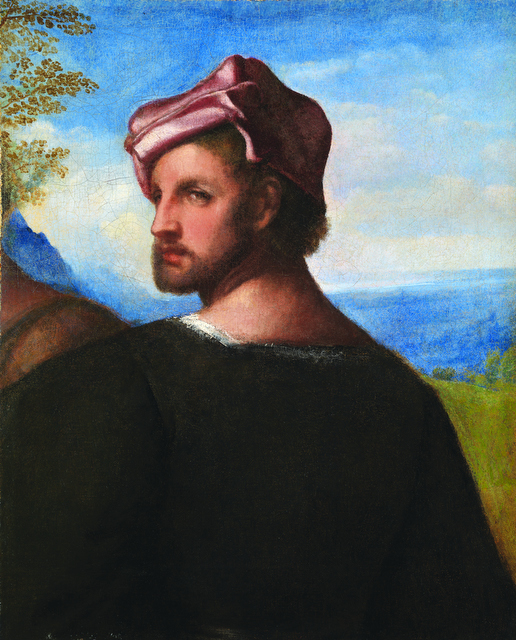Italian Renaissance Comes to Santa Barbara
Santa Barbara Museum of Art Displays Major Works from the Renaissance and Beyond
One of the best collections of Italian painting in the world will be spending the winter and early spring of 2015 in Santa Barbara. Botticelli, Titian, and Beyond: Masterpieces of Italian Painting from Glasgow Museums, which opens on Sunday, February 8, and continues through May 3, will take up four galleries at the Santa Barbara Museum of Art (SBMA) with 50 works spanning 500 years of Italian art history. Based on the collection of Archibald McLellan, a 19th-century Glasgow coachmaker, and including both works later donated to that city’s museums by other civic-minded Scots and comparable paintings from the SBMA’s own permanent collection, this powerful survey tells the story of a continuous tradition that has long been considered the central development in the history of Western art.
From the discovery of the mathematical principles of linear perspective to the invention of such modern genres as lifelike, personalized portraiture and detailed, specific landscape, the Italian Renaissance provided the techniques and the inspiration that guided the development of visual art around the world for centuries to come. Representational painters still learn perspective by viewing and analyzing the works of the Italian masters, and abstract artists have long acknowledged the influence of supreme colorists such as the Venetian painters Bellini and Titian on their compositions. With the arrival in our city of this comprehensive collection documenting the evolution of painting in Italy over half a millenium, visitors to Botticelli, Titian, and Beyond will enjoy a unique opportunity to learn firsthand what made the Italian Renaissance a gold standard for artistic excellence.
In an era of museum programming that’s more and more frequently devoted to showing modern and contemporary art, it’s refreshing to rediscover the excitement and sheer pleasure of looking at the canon. Many of these pictures have been significantly restored for this show and are thus being seen for the first time in centuries in a condition resembling how they looked when they were first created. Co-organized by the Glasgow Museums and the American Federation of Arts, the exhibit fulfills a mission of public education that has been in place at least since Archibald McLellan left the core of this collection to the city of Glasgow in his will of 1853. His Deed of Bequest includes the following eloquent and ambitious statement of purpose:
… being impressed with the belief that the study of what are called the “Fine Arts” is eminently conducive to the elevation and refinement of all classes, as well as intimately connected with the manufacturing and mercantile prosperity of this community — from these various motives, and on account of my long connection with Glasgow and its various public bodies, and as humble testimony of my attachment to its citizens, and my desire for their welfare and elevation, so far as it is in my power to aid in the promotion of these, I have resolved to devote my said collection to public use and exhibition …
There’s more to this than meets the eye, however, as McLellan died deeply in debt thanks to real estate deals gone sour, and it took the Glasgow city council some time to accept the collection, as it involved assuming McLellan’s posthumous financial obligations, as well. Nevertheless, it was in the long run a wise decision, as collectors from succeeding generations increasingly saw fit to make further contributions to what wound up being a highly significant civic legacy. The show’s earliest work, a portrait of St. Lawrence from 1370, was a gift from Julius Lewis Lyons in 1970, and the collection acquired its pair of giant Salvator Rosa landscapes in 1952 and 1953.
For Larry Feinberg, the director and CEO of the Santa Barbara Museum of Art, this show represents another culmination of his extensive scholarly involvement in Italian art. Feinberg’s excellent, highly readable book on Leonardo da Vinci, The Young Leonardo (Cambridge University Press, 2011) is the most recent of his several publications on the art and society of the period. Feinberg will be providing expert commentary on the exhibition in a public lecture scheduled for Thursday, February 19, at 5:30 p.m.
In addition to the director’s highlights lecture, the museum has a range of other events planned to supplement the exhibit, including a reading and discussion Thursday, March 12, at 3 p.m., by the Irish author and Columbia University professor Colm Tóibín. Tóibín’s recent novel, The Testament of Mary, a revisionist account of the life of the Virgin Mother, was inspired by two paintings by Titian. Those seeking a different, and perhaps more social, experience would do well to consider attending the Atelier event scheduled for Friday, February 27, at 5:30 p.m. The theme for the evening is “Primavera in Winter,” and the program includes contemporary dance, Renaissance music, participatory fresco painting, Italian food, wine, and a signature cocktail, the “Sacred and Profane.”
However you plan to approach Botticelli, Titian, and Beyond, there are some things you won’t want to miss. With 50 images spread over five galleries, everyone will have his or her own favorites, but there are also several paintings that are particularly significant, either as art historical landmarks or simply as incomparable viewing experiences. What follows are short descriptions of three of the best — the show’s big pictures.

Botticelli “The Annunciation,” c. 1490-1495
Sandro Botticelli, best known for his “Primavera” and “The Birth of Venus” (a k a “Venus on the Half Shell”), revisits one of the most popular (at least among painters) episodes in the Gospels with this fascinating and highly unusual version of the Annunciation. The elegant curvilinear figures of the Angel Gabriel and the Virgin Mary are nearly upstaged by an elaborate demonstration of geometrical perspective that’s anchored by a massive central column in the extreme foreground. Only the power of God, here represented by a delicate diagonal shaft of golden light, can penetrate the Virgin’s inner sanctum.
Gabriel, who enters from the left on tiptoe, carries a symbolic lily as both a sign of Mary’s virginal status and a reference to the civic emblem of Florence. Botticelli painted this picture, possibly with the help of an apprentice, at a relatively late moment in his career and during the period in which Savonarola was active in Florence. Whether or not Botticelli contributed any of his earlier paintings on mythological, nonreligious subjects to Savonarola’s famous “Bonfire of the Vanities,” it’s clear that this late work represents a return for the artist to the fundamentals of Christian faith from the mysteries of pagan legend.
What’s great about this painting is the balance it achieves between the gothic-influenced flowing outlines of the figures and the deep space implied by Botticelli’s radical embrace of geometrical perspective. The entire composition, with its rhythmic deployment of strong verticals and shadowed arches, signals yet another way forward for painters in pursuit of a sense of total unity. It’s easy to imagine 20th-century painters from Giorgio de Chirico to Frank Stella reveling in the complex harmonization of so many geometrical elements.

Titian “Christ and the Adulteress,” 1508-1510
Until quite recently, this massive canvas was attributed to Giorgione, the enigmatic painter of “The Tempest,” but in the past two decades, a consensus has formed around the idea that it is an early picture by Titian, probably painted when the painter was in his early twenties. A now-separate painting, also on display and known as “Head of a Man,” was cut from the larger canvas at some point. A period copy of “Christ and the Adulteress” shows that the triangular shape protruding from the right to be the shape of the standing man’s knee. Reduced to a portrait, “Head of a Man” nevertheless retains great charm, not least due to the fact that it appears to be an image of the artist himself.

The main painting shows what made Titian the undisputed king of the early cinquecento. Choosing the episode from John 8:2-11 in which Christ, confronted by the Pharisees with the case of a woman who was caught in flagrante as an adulteress, Titian actualizes the Savior’s memorable retort — “He that is without sin among you, let him first cast a stone at her” — through a pictorial vocabulary of color and gesture. Christ’s right hand provides a focal point as he seems to restrain the woman’s central accuser and reach out to her at the same time. Elegant contemporary Venetian clothing accentuates the timeless validity of Christ’s moral lesson, which is not so much that sinners have no right to accuse as that they should think long and hard before participating in the punishment of others, particularly in a punishment that’s likely to end in death.
The multilayered action includes not only the three central figures but also a half dozen others (counting the figure that was cut out) and even a flock of sheep basking in sunlight on a distant hillside. While it may not have the logical consistency one expects from Titian’s mature works, the painting represents an important breakthrough in the evolution of pictorial narrative. These are real people in a real space, and their story is told through their postures and gestures. It will be another hundred years before Rembrandt and Velázquez follow up on the full implications of what Titian is doing here.
Giovanni Bellini “Virgin and Child,” c. 1480-85
Bellini specialized in these half-length images of the Virgin and Child, and this is one of the supreme examples of his total mastery of this most popular of devotional genres. The colors of this painting have faded with time, but it nevertheless still glows with the inner light that was Bellini’s particular contribution to the technical repertoire of the oil painter. Both Mary and the Christ Child, who stands in a kind of baby contrapposto on a conveniently located shelf, look down and to the left, with the child in a posture of blessing and the mother in an attitude of solemn contemplation.
There’s an exquisite balance in this image between the human and the divine. Both figures benefit from full individuation — they are specific people in a specific moment — but there remains something otherworldly about their attitudes. The child gazes into an indeterminate distance, intent on something the viewer will never see. His mother, her exquisitely rendered left hand barely brushing his belly, appears to have some mournful foreknowledge of her son’s eventual fate. The Virgin’s red dress and blue robe are consistent with the iconography of thousands of similar images, yet Bellini manages to invest Mary’s entirely conventional attire with an unusual feeling of quiet authority. Finally, there’s the diaphanous drapery of her headgear, which forms a halo out of the painter’s extraordinary skill with crosshatching for effects of light and shadow.
The contemplation of these Virgin and Child images by the religious only scratches the surface of their impact on world culture. Regardless of the angle from which one approaches such depictions of the spiritual bond between mother and son, they resonate with the deepest of human impulses, those that seek to protect and nurture the young. In this painting and others like it, Bellini achieved a kind of quintessence of the form, narrowing the focus from the more traditional retinue of saints and/or magi down to just the central pair. It’s this progression from the devotional to the elemental that gave the Italian Renaissance its universal appeal.
Botticelli, Titian, and Beyond: By the Numbers
Total number of artworks: 50
Saints: 14
Virgin Marys: 11
Christ children: 9
Rebel angels: 9*
Angels: 7
Martyrs: 8
Magi: 6
Adult Christs: 5
Self-portraits: 2
Severed heads: 2
*All nine rebel angels are in one painting, and they are being thoroughly scourged by the Archangel Michael.



